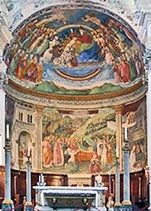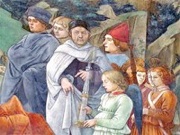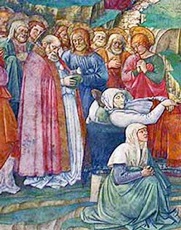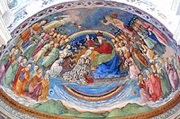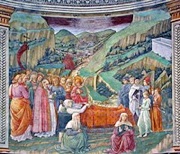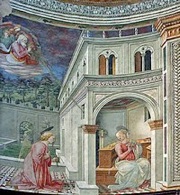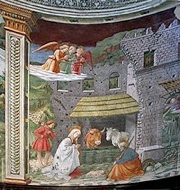In 1466, the Opera del Duomo incurred considerable expenditure for the materials that were to be used for the frescoes in the apse. Regular payments were made to the artist Filippo Lippi in the period 1466-9, often through his "garzone" (apprentice) Pier Matteo d' Amelia and sometimes via his colleague Fra' Diamante.
Filippo Lippi introduced a self-portrait in the central scene: he wears his Carmelite habit and stands among his colleagues. His son, Filippino is depicted as an angel. Filippo Lippi died in late 1469 and his colleague completed the work in 1470.
According to Giorgio Vasari, the Commune had asked Cosimo de' Medici to persuade Filippo Lippi to take on this project. Cosimo died in 1463, but it is possible that his aid had been sought shortly before this. Given his close interest in the work, Bishop Cardinal Berardo Eroli must have been involved in securing the commission, perhaps through his contacts with Bishop Antoninus Pierozzi of Florence and Giuliano de' Medici. Antoninus Pierozzi, who had died in 1459, is depicted among the Apostles in the central fresco, wearing a red cloak reading from the Book of Psalms. This might have been due to the influence of Lorenzo de' Medici, who was pressing for the canonisation of Antoninus Pierozzi in the 1460s. (He was finally canonised in 1523).
There were a number of occasions when the demolition of the apse was considered in order to build a deeper one that would allow more room for the canons and other dignitaries during important services. These plans never came to fruition, presumably because the frescoes were highly prized. They were however cut down at the sides during the final re-modeling of the Duomo in 1785-92.
Coronation of the Virgin
In the lunette above the apse, the Virgin is shown in Heaven after her Assumption. God the Father crowns her in a mandorla formed by a rainbow, surrounded by a heavenly choir. The figures in the bottom row, which are identified by inscription, are mostly prophets: the innermost two are Adam (on the left) and Eve.
Dormition of the Virgin
In the central scene, the Virgin lies on her death bed against a hilly landscape. Two of her women kneel in prayer beside her bed. The coffin from which she will ascend to Heaven is depicted on the hill to the right.
As noted above, the scene includes contemporary figures:
-
✴Bishop Antoninus Pierozzi of Florence stands among the Apostles, reading from the Book of Psalms.
-
✴Filippo Lippi, his workshop and angels (including one with the face of his son, Filippino) stand at the foot of the bed. Filippo Lippi makes eye contact with the viewer and points to the dying Virgin.
Annunciation
The scene on the left depicts the Annunciation. The Virgin is seated in a loggia as the Angel Gabriel makes his announcement and God the Father appears in the sky to the left to effect the incarnation.
-
✴The face of the Virgin is a portrait of Lucrezia Buti, Filippo's mistress and Filippino's mother.
-
✴The frieze above the loggia is inspired by that of the Roman temple.
-
✴The capitals of the columns of the loggia are inspired by those of two columns at San Salvatore.
Nativity
The scene on the right, which depicts the nativity, is probably largely the work of Fra' Diamante.


